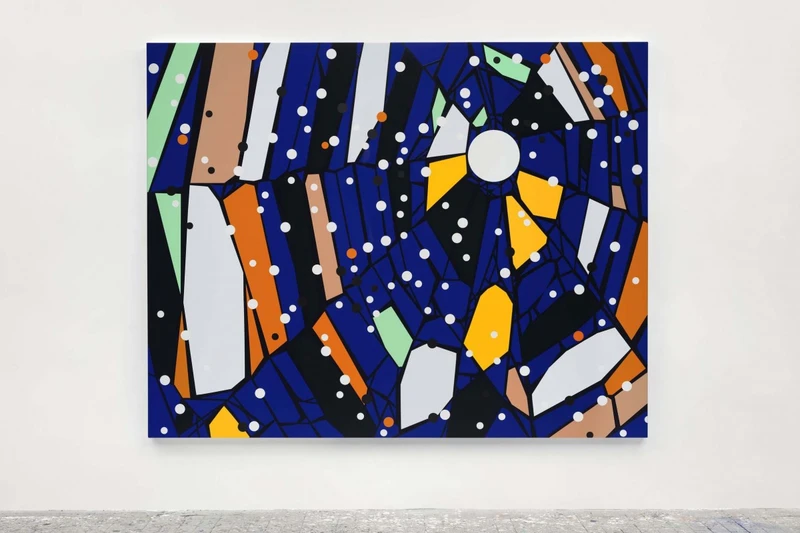Sarah Morris: Means of Escape
19 Nov 2021-9 Jan 2022


White Cube Bermondsey is pleased to present an exhibition of new works by Sarah Morris. Featuring films, paintings and works on paper that explore and create an architecture of forms, the exhibition furthers Morris’s interest in the psychology and perception of space and time.
Morris considers the city as a living, evolving organism and thinks of these new paintings as ‘anthropocene forms’ − functional, engineered, yet fragile. She says that her paintings create ‘an internal, imaginary, spatial sense that is slow, precise and quite open [...] a set of images and realities that haven’t been made before’. In her new ‘Spiderweb’ series, she draws on the recent experience of enforced restrictions and confinement that has resulted in an abrupt shift in temporal focus and social habits. Taking the improvised form of a spiderweb as their starting point, the paintings’ arrangements of lines converge, creating shard-like shapes and dots of varying sizes, which emerge, hover and recede from the paintings’ surfaces. Rendered in Morris’s recognisable palette, the paintings explore spatial disorientation, perception and cognition.
Morris has long been fascinated with engineered yet ephemeral structures which operate as both interior space and complex networks. Her paintings remind us of our flawed ecosystem and the cities we inhabit, at one moment condensed and populated yet with the potential to be swiftly abandoned. In their resemblance to a flag, they further consider propaganda and the internalisation of signs. The idea of networks, global interconnectivity and systematic visual forms, which have been the cornerstone of Morris’s practice, are also at play in the film poster drawings shown together for the first time. Presented on a single wall, these works attest to modes of communication, distribution, advertising, and the ways in which the semiotics of graphics are geographically positioned, and loaded with historical and political forces. In these works, which combine the readymade with drawing, abstract forms are overlaid on original posters of iconic films. The selection of films are particularly significant for Morris, whose own work deals with conspiracy, power structures and networks – and their potential subversions. Several of the films, for example, feature screenplays by Robert Towne, who is the title and subject of one of Morris’s earlier films from 2006, while others represent a synchronisation of subject, style and theme reflecting political epochs, as can be seen in Rio (2012), Beijing (2008) and Capital (2000).
Her last film shot before the global pandemic, Sakura (2018) focuses on Osaka, Japan’s second largest city and the original capital. The film was staged precisely at the time of the blossoming of the Sakura tree. Commissioned by the Nakanoshima Museum of Art, the film is immersive, with the camera employed to reveal both the macro and the micro by cutting through the many layers of the city, a telescoping also present in the 1977 film Powers of Ten by Charles and Ray Eames, commissioned by IBM. Exploiting and playing with the genres of documentary and fictional filmmaking, in Sakura Morris depicts both real and fabricated time. The artist describes her films as an ‘open system of coordinates’; an unfolding, interrupted index of the contemporary.
Sakura features footage from various sites of industry and commerce, education and leisure including: the Sakura pastel factory; the National Museum of Ethnology and the UNESCO world heritage site of the Bunraku puppet theatre (both designed by the legendary architect Kiro Kurokawa); Renzo Piano’s Kansai International Airport; the Yamazaki Suntory Whiskey Distillery; and the laboratory of Nobel Prize winning molecular scientist, Dr. Shinya Yamanaka, the pioneer of the pluripotent stem cell. Set to an original score, the film creates a fragmented, rhythmic structure, presenting us with a hypnotic nexus of images.